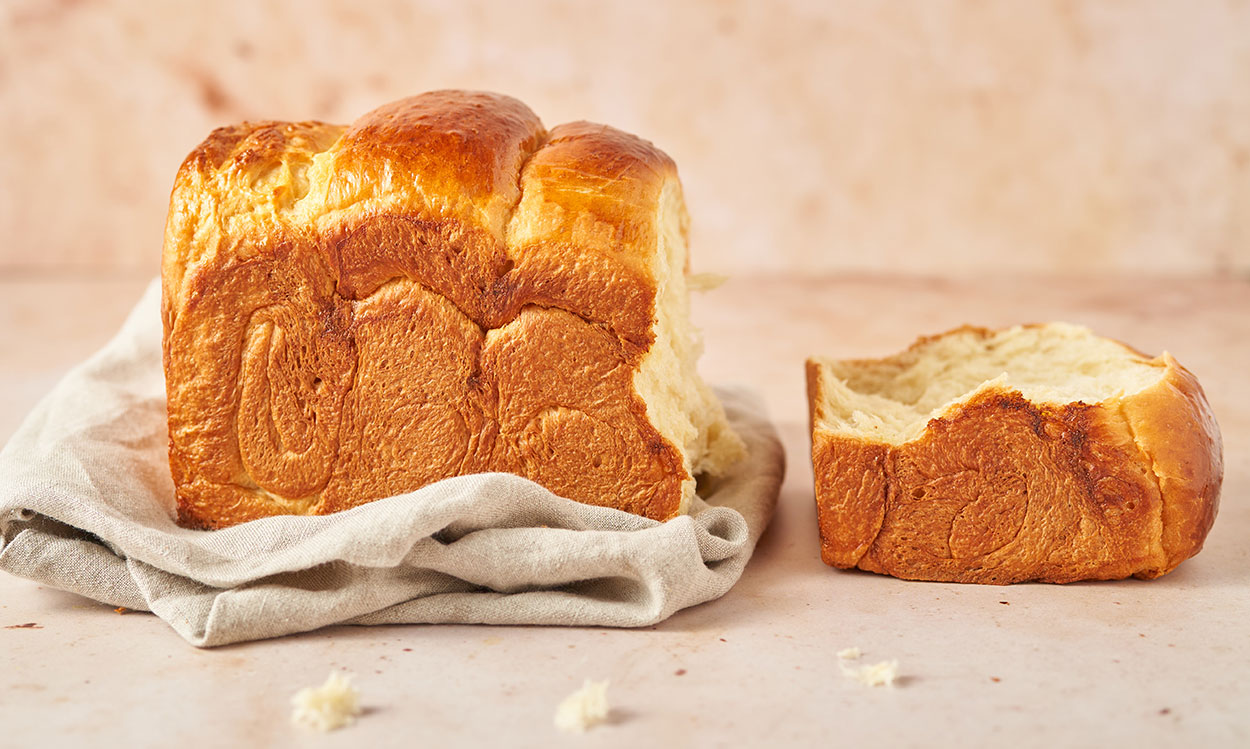
Hokkaido (Japanese) Milk Bread
Ingredients
Tangzhong (starter)
- 43 grams water 3 tbsp
- 43 grams whole milk 3 tbsp
- 14 grams bread flour 2 tbsp
Dough
- 298 grams bread flour 2 ½ cups spooned and leveled
- 14 grams dry milk 2 tbsp
- 50 grams sugar ¼ cup
- 1 tsp salt
- 1 tbsp instant yeast
- ½ cup milk
- 1 egg
- 57 grams unsalted butter room temperature 4 tbsp
Milk Egg Wash
- 1 tbsp milk
- 1 egg
Instructions
For the tangzhong
- Combine water, milk, and flour in a small saucepan and whisk until no lumps remain.
- Place the saucepan over low medium heat and cook the mixture whisking until thicked and whisk leaves lines on the bottom of the pan. It should have almost a paste-like consistency about 4-7 minutes.
- Put in fridge or on your countertop and allow to cool to room temperature . You can keep it in the fridge for up to 6 hours just make sure to allow the mixture to come to room temperature before using.
For the Dough
- Grease your bread tin lightly with butter. We used a 21.5 x 13 x 12cm loaf pan.
- Into the bowl of your stand mixer fitted with the dough attachment add the dry ingredients;, bread flour + dry milk + salt + yeast + sugar. Mix on low to combine ingredients.
- Add the wet ingredients; tangzhong + egg + milk and mix on medium until dough forms and is coming off the side of the mixing bowl. Scrape down the sides of the bowl.
- While your mixer is still on medium speed add your room temperature butter chunk by chunk, incorporating each one before adding the next. Then increase the mixer to medium-high for about 8 minutes until the dough is completely coming off the side of your mixing bowl and looks smooth. The dough should be elastic when you stretch it.
- Remove from mixing bowl and form dough into a tight ball, place in a lightly greased bowl and cover with cling film or a towel. Allow to proof in a warm area for 60-90 min. The dough does not necessarily need to double in size (ours did) but should rise significantly. Poke the dough with your finger it should not spring back.
- Divide dough into 4 equal pieces.
- Grab one piece of your dough and fold it on to each other to form a ball. Then using your hands and the surface of a table roll it so that it is seamless. Repeat for the rest of your dough pieces.
- Cover the dough balls with a towel while you work on each one.
- Roll out your dough ball gently into an oval shape around 25 x 10 cm, it does not need to be exact. Take the top part and fold downwards to the center. Then take the bottom part and fold upwards like you are folding a letter. Turn your dough to the side so that the seem is now vertical. Roll out again to the same oval shape. Roll up your dough into a log shape, and pinch the seam to close. (refer to blog post or images)
- Place seam down into your greased bread tin.
- Repeat with the rest of your dough balls, placing each seam-side down into your bread tin.
- Cover with a towel or cling film and let your dough proof for another hour or until it almost fills your bread tin. Leave 1-1.5cm from the top of your tin, so that dough has room to rise when baking. (Proof time will depend on the temperature of your kitchen). The cooler it is the longer it will take for your dough to fill your tin).
- Preheat your oven to 175°C. If you have an electric oven use the fan option.
For the Milk Egg Wash
- Whisk 1 tbsp of milk with 1 egg until very well incorporated. If you are out of eggs you can also use just plain milk.
Baking your Dough
- When your dough has almost filled your tin, gently brush the top of your dough with your milk-egg wash using a pastry brush.
- Place in your oven to bake for 25-30 minutes, an instant-read thermometer inserted into the center of your loaf should read 87.7°C (190°F).
- Remove your loaf tin and let your milk bread cool in the tin on a cooling rack for 10 min.
- Invert bread onto a cooling rack. After cutting cover in cling wrap to keep it fresh.
Notes
Different pans and shapes :
For small dinner rolls. just divide the dough by 9 instead of four, skip the log shaping above. Just proceed to roll each piece of dough into a tight circle, then grease a 22x22cm (9x9in) cake pan and place the dough balls in rows of 3 leaving room between each. Allow to proof and bake according to the above directions.
You can also use a circular pan, grease a 20-22cm (8-9in) round pan, divide your dough into 8 pieces. Grease your cake pan, place one dough ball in the center and the other 7 around it leaving a bit of room between each. Allow to proof then bake according to the above instructions.